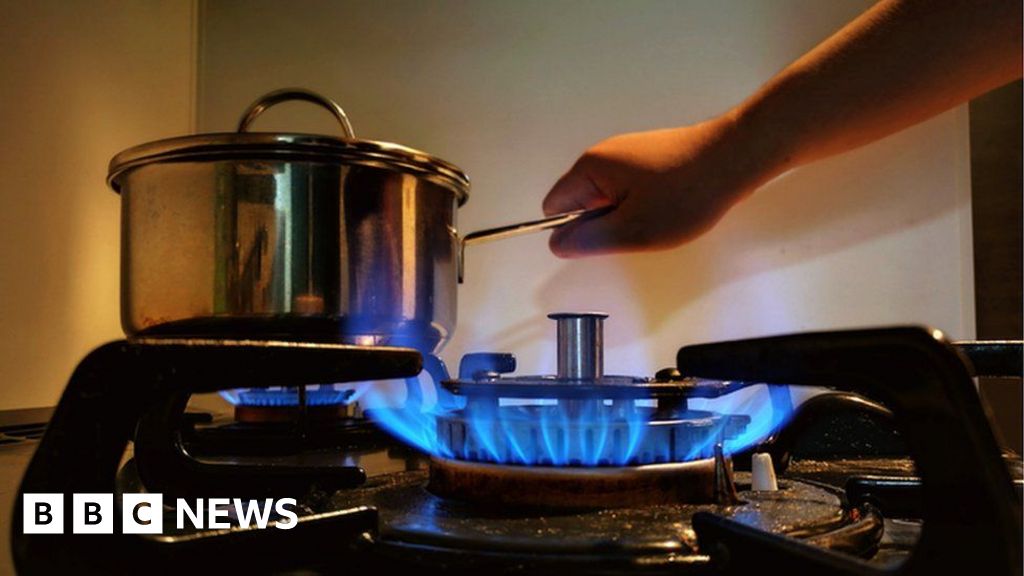London’s most exciting chef’s table restaurants

This article is part of a guide to London from FT Globetrotter
I am closely watching a young chef skilfully stuff sweetbreads between the fat and flesh of a French-trimmed rack of lamb. We are in the tiny former beer cellar of an 18th-century pub that converted into a restaurant with only 12 countertop seats semi-circling an open kitchen. Three chefs beaver away with production-line efficiency; when a dish is ready, one of the men presents it with an explanation to an eager diner. The sommelier is also host and busser. Everyone works front of house.
Chef’s table restaurants — where fine dining meets immersive theatre — have been cropping up in interesting spaces around London, offering diners insider access to some of the city’s most serious cookery. These venues are a playhouse for the gastro-curious (or MasterChef obsessives): the kitchen is the stage and a secret tasting menu, the restaurant’s sole offering, is the performance. Only a dozen or so bookings are available per night.
The concept is not entirely new. Like much of modern fine dining, it stems from Japanese tradition: omakase, which translates to “I leave it up to you”, the method of countertop dining in which guests leave themselves in the hands of the chef. In return they receive an elegant several-course meal with an emphasis on premium ingredients and seasonality. Omakase requires a chef’s full attention and privileges the happiness of the guest, so only a limited number of diners are served per night.
In London, chef James Knappett was at the forefront of applying this style of dining to modern British or European cuisine. “All of Gordon Ramsay’s restaurants had chef’s tables in the [dining] room, so I had an early experience of how it works,” says Knappett, who started his career working for the mercurial star at Royal Hospital Road. After dining at omakase restaurants in Los Angeles and New York, Knappett sought to apply that approach at his own venture, Kitchen Table, and in recent years similar countertop concepts have sprung up in his footsteps.
“What’s cool is that restaurants like this are driven by chefs,” Knappett says of his peers, who also tend to possess résumés riddled with the names of culinary royalty. Given free rein to experiment, these chefs are clearly having a lot of fun, churning out dishes that are joyous, creative and mind-bendingly impressive. They enjoy divulging their secrets — curious diners will no doubt leave having learned something too.
There are two downsides: one is that reservations open infrequently and are usually snatched up shortly after going live. However, consider it like securing tickets to a music festival (though once you’re there, the other guests have probably showered). Set a calendar reminder, be online at the right time and act quickly. The other catch is that they’re expensive, and with rising inflation, a plummeting pound and labour and ingredients shortages (what a time to be alive), some have become even more so.
Despite sharing a similar concept, each restaurant featured here offers diners a totally unique setting and gastronomic adventure. Go for an intimate meal with a companion, or a communal experience with other diners, though my advice is to opt for the latter: the countertop set-up, theatricality and synchronised service (combined with a few glasses of wine) can make for a lively meal en masse. Bring a curious mind — and empty stomach — and get stuck in.
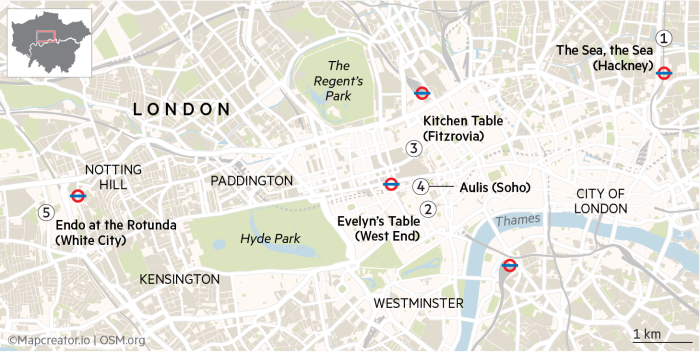
The Sea, The Sea (Hackney)
337 Acton Mews, London E8 4EA
-
Good for: A brilliant seafood showcase
-
Not so good for: Anything else. The Sea, The Sea is a fish merchant by day and the chef’s table is all about flaunting the merchandise
-
FYI: Bookings open every two months. Limited to 14 seats per evening; £150 per person (prepayment required). Open Wednesday to Saturday
-
What to drink: The wine list favours small producers with an emphasis on sparkling and white, alongside some great reds and sakes. Ask restaurant manager Pedro Abreu for a recommendation

“Fish is best when it’s fresh — except when it’s aged,” said Alex Hunter, The Sea, The Sea’s founder, as we admired the hanging bodies of monkfish, trout and turbot in the dry-ageing cabinet at their east London locale. The chamber’s walls are tiled with pretty pink blocks of Himalayan salt; if it weren’t for the corpses, it would look like an influencer’s bathroom.
Different species of fish react differently to the process, but in general ageing fish is likened to ageing meat: it intensifies the flavour and softens the flesh. The Sea, The Sea, who supply more than 100 restaurants in London and the south-west, with fish caught by low-impact boats along the south coast, are local specialists.
The company’s chef’s table opened last year as “a stage to showcase the product”, says Hunter. Each day, executive chef Leo Carreira, an alumnus of Mugaritz and Nuno Mendes’s Viajante — and a pioneer in dry-ageing fish — takes his pick of the arrivals and decides whether to age, smoke, cure or apply some other form of magic to the creatures. Each dish evolves from his chosen technique and preparation. They are absurd and extraordinary.


The 13-course menu highlights produce and processes that even ardent food nerds would be impressed by. What looked like a piece of nigiri turned out to be a thin slice of dry-aged kingfish sprawled atop a nori-flavoured meringue. Glass noodles (created with onion broth and held together by kuzu, a gluten-free thickening agent) were served in a refreshing dashi made with smoked eel and toasted rice — something that itself is seemingly simple but is technically demanding. The benefits of ageing fish became even more evident with grilled trout, so flavourful yet soft, served with a banana and hazelnut miso sauce that could be eaten by a fish merchant’s bucketful.
How might such a fish-focused endeavour do pudding? Spoiler alert: with a bit of fish. Carreira’s Pão de Ló, a Portuguese sponge cake that he topped with toasted fennel-seed ice cream and a dollop of caviar, is a thrilling entanglement of flavour, texture and temperature.
“We’re trying to do something fun, something a bit different,” Carreira said of his menu as Squid Game-like music thumped in the background. Indeed. I stepped out of the dark, cavernous space feeling slightly drunk with bewilderment (and also an excellent Sicilian wine). Those who possess a granular interest in what they eat — or a journalist’s affinity for interrogation — will certainly take in more at The Sea, The Sea than a superb meal. This is experiential dining at its best.
Evelyn’s Table (West End)
The Blue Posts, Cellar, 28 Rupert Street, London W1D 6DJ
-
Good for: A fun and joyous menu combining Japanese and French flavours and techniques (head chef Luke Selby has worked with Raymond Blanc, Clare Smyth and Ollie Dabbous, and has done a stint in Tokyo too)
-
Not so good for: You won’t stop talking about it
-
FYI: Bookings open on the 1st of every month at noon for the following month. Limited to 12 seats per service; £120 per person (prepayment required). Open Tuesday to Saturday (sittings at 6pm and 8.45pm)
-
What to drink: It’s worth adding the beverage pairing — an interesting tasting menu in its own right, which ranged from cider made the champagne method, to sake, to an obscure Greek wine. It’s £80, or £55 for the little or no alcohol pairing, which the diners next to me said was excellent

Well, I hate to say it, but if we really want to irritate the French, it’s time to move on from banging on about British cheese. Instead, share how the best beef tartare, possibly anywhere in the world, is being made in the heart of London, where it is diced and dressed, sprinkled with a little bit of wild-nettle tempura for tasty texture, and served on a large English wasabi leaf. It’s unique, it’s gorgeous — and must be destroyed: rolled up, eaten with hands and devoured like a frat boy shotgunning a late-night taco. Yum.
For this we can thank the brothers Selby — head chef Luke, and Nat and Theo, his younger siblings and sous chefs — the trio behind the counter at the Michelin-starred Evelyn’s Table, a tiny subterranean restaurant in The Blue Posts pub’s cellar. Every aspect of Evelyn’s Table has an element of fun, from its speakeasy vibe (on arrival, you are led down a narrow staircase, past the loos, to a door marked “Private”) to surprise courses and the old-school hip-hop playlist soundtracking your meal. “It’s our food, it’s our music,” says Luke. “We want it to feel really high quality but relaxed, like people are coming over to our home for dinner.”

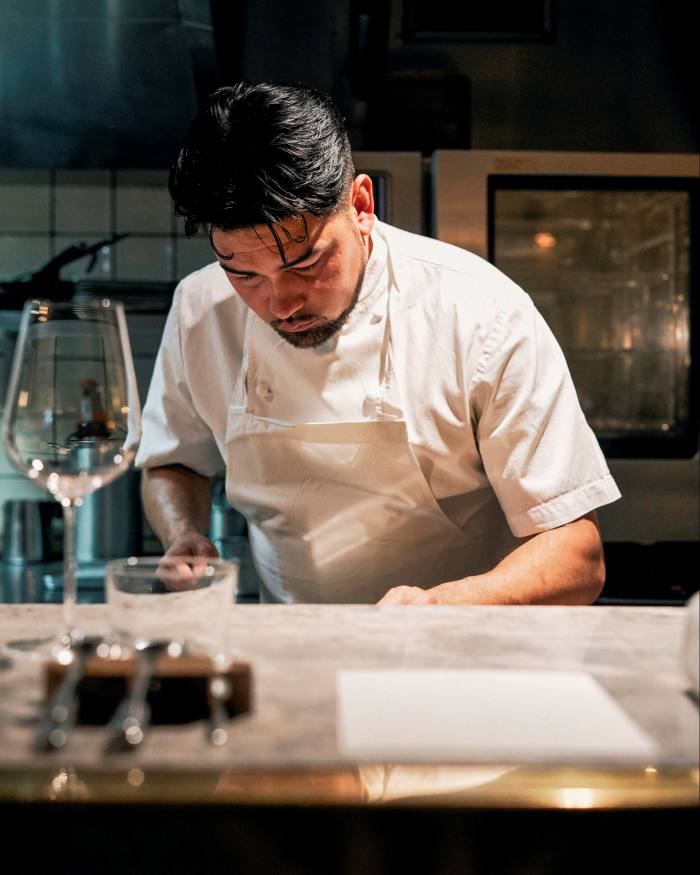
Like the tartare, the whole menu makes you smile: original, amusing and prepared beautifully — the product of classic French and Japanese flavours and techniques applied to peak British produce, with a wink.
It typically starts with sashimi, such as hand-dived Orkney scallops, opened just before guests arrive to preserve their natural sweetness, served with a concentrated tomato essence (“an homage to Raymond Blanc,” Luke says) and finished with a fruity olive oil. A take on shime saba, Japanese cured mackerel, followed, before a show-stopping courgette flower stuffed with crab mousse, served with courgette purée and finished with a bisque that is itself layered and impressive. Lamb, cooked with a herby Provençal-style breadcrumb, is lightly smoked over burning hay as it’s presented to diners who “ooh” and “ahh” before it’s carved and served.
To even greater delight, the brothers always serve a bao, a steamed bun, as a surprise: when I visited it was filled with grilled lamb belly, seasoned with cumin and black pepper, and served with a date ketchup. “That’s why I love cooking and why I got into it,” Luke says. “You’re giving something that you’ve made and feel very passionate about to somebody else, and there’s such joy in that act.”
Kitchen Table (Fitzrovia)
70 Charlotte Street, London W1T 4QG
-
Good for: Showcasing the beauty of British produce with abandon — chef James Knappett is a feeder (and doesn’t shy away from big-hitting ingredients such as lobster, foie gras and caviar)
-
Not so good for: Your finances and cholesterol levels
-
FYI: Bookings are released by the month, three months in advance. Limited to 19 seats per evening; £300 per person (prepayment required). Open Wednesday to Saturday
-
What to drink: Grower champagne. The impressive selection is curated by sommelier Sandia Chang, Knappett’s wife and Kitchen Table co-founder, who also runs a wine merchant dedicated entirely to small-scale fizz
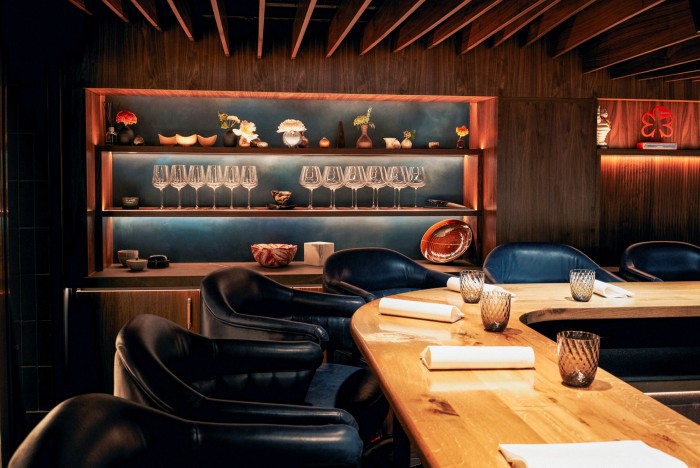
Halfway through a meal at Kitchen Table, I seriously questioned if, like Roald Dahl’s Violet Beauregarde, my entire body was inflating as a result of greed. I should’ve gone easy on the bread course, but carbs are my kryptonite and it was too good to stop: a crispy exterior enveloping warm and pillowy pull-apart pieces, with a peppery, green butter (it had been whipped with grass). I felt dangerously close to exploding like a giant human blueberry.
Kitchen Table had been on my restaurant radar for a long time, but reservations are so in demand that finally getting a seat can feel like winning one of Wonka’s golden tickets. It’s no wacky chocolate factory, however: the two-Michelin-star Kitchen Table is the Monaco Grand Prix of chef’s tables. It’s the place to go big.


The evening begins in the bar area, where guests have an aperitif and their bouches amused with an array of intricate snacks (an oyster with apple granita, a hay-smoked quail’s egg, a crispy chicken-skin wafer). After being led to the kitchen to take our seats, the real show kicks off: scallops (served raw with shavings of roe); white asparagus (with rhubarb and lovage); crab with foraged elderflower vinegar that is fermented in house; lobster with a Goan curry powder and caramelised mango chutney (chef’s kiss); trout, aged for two weeks, fried in fois gras fat, served with fried brioche, and topped with fois gras in case your left arm hasn’t signalled a heart attack yet; brill with a dollop of caviar; and, at this point — clothing feels unbearably constrictive now — a deconstructed baked potato of all things, emulsified with 50/50 butter and cream, and smoked eel, to gear guests up for an enormous cut of lamb that’s been teasing you by slowly cooking in the back corner all night. And then . . . dessert! Pear tarte Tatin with Suffolk Brie — a gorgeous juxtaposition of salty and sweet; a strawberry and elderflower whipped cheesecake that conjures Wimbledon, and a something-or-other with rhubarb that was grown in the dark, I think? My notes were indecipherable by now. Oh, and petit fours. Then a loss of consciousness.
Knappett’s food is elegant, refined, cooked with panache and unfathomable skill, yet it’s showy, unapologetic and loud — like a supercar on a plate. He would tend to agree. The menu price was increased in July (briefly driving the news cycle in chef circles), largely because of shortages and his refusal to sacrifice certain ingredients. “We’re serving the best turbot, the best caviar — you get what you pay for,” he says. Questioning the cost, he jokes, “is like going to a Ferrari dealership and asking why the cars are so expensive”.
The result is a dizzying display of conspicuous consumption (it feels weird writing about it in this economy). But this is special-occasion stuff, celebratory feasting — a Big Night Out, for all intents and purposes. You could have Bezos’s billions and still couldn’t dine like this all the time. Otherwise you’d probably be dead.
Aulis London (Soho)
16a St Anne’s Court, London W1F 0BF
-
Good for: A convivial, relaxed experience enjoying stunning, sustainability- focused cookery
-
Not so good for: Social distancing. The eight-seat space is very intimate
-
FYI: Bookings open every three months; £155 per person (prepayment required). Dinner-only, Tuesday to Friday; lunch and dinner, Saturday. It’s also available for private hire
-
What to drink: Add one of the wine pairings, crafted by sommelier Charles Carron Brown. Each highlights reliably good wines alongside a couple of lesser known but equally tasty selections. (An alcohol-free pairing is available too.)
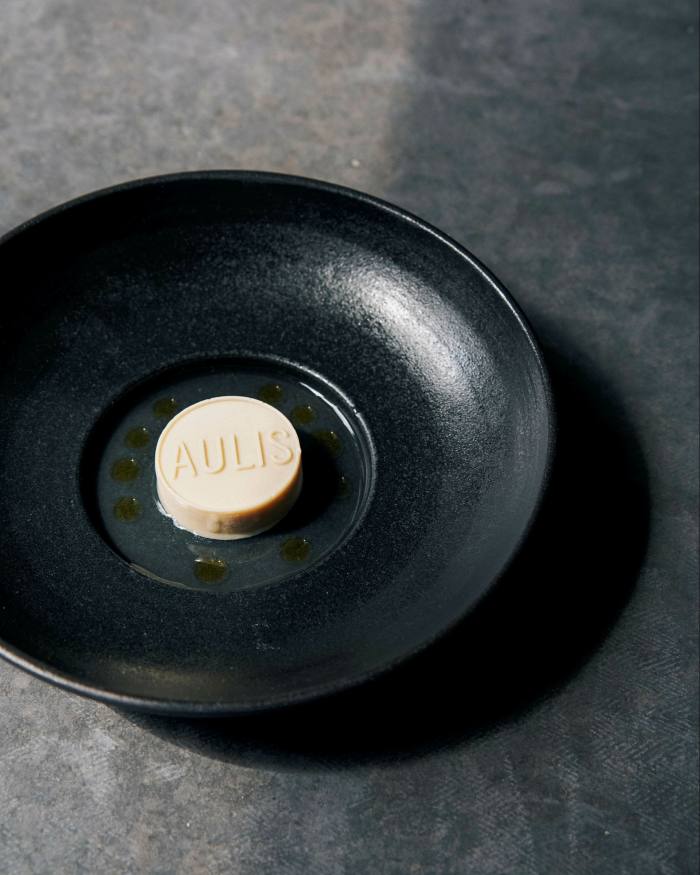
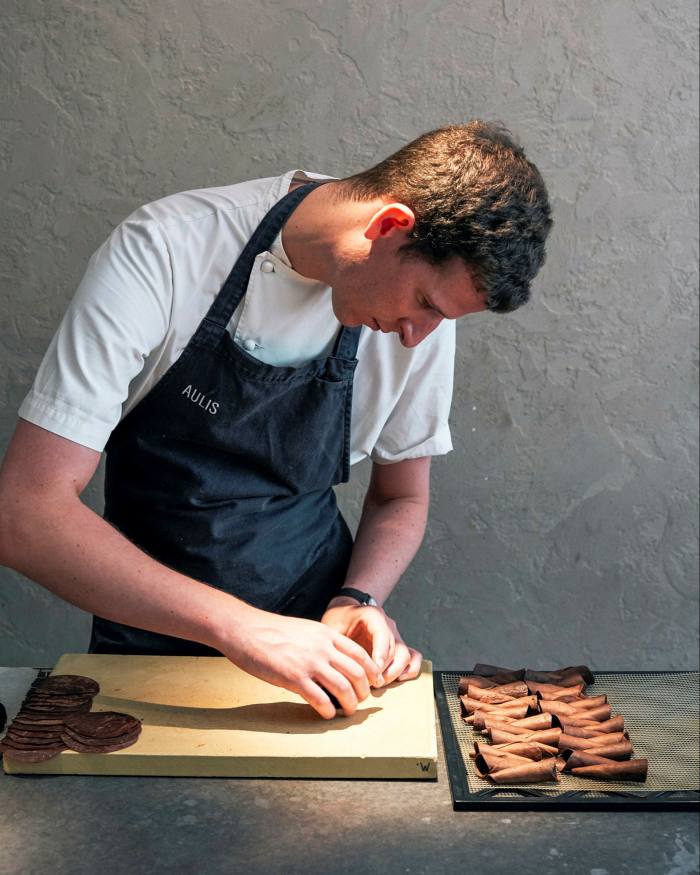
Seeking out Aulis, Simon Rogan’s compact chef’s table, feels akin to looking for a secret spa concealed in one of the city’s most frenetic neighbourhoods. It’s nestled down an alleyway off Wardour Street, and the atmosphere inside the minimalist space is not what you’d expect from an upscale restaurant with a total staff count of three. The ultra-relaxed vibe is meant to be “like stepping into a warm bath”, says Charlie Tayler, Aulis’s head chef, who previously worked at The Ledbury and was mentored by Alyn Williams at The Westbury. “We work really hard [before the guests arrive] . . . to be mellow and chilled when service begins because it’s so guest-facing and interactive.”
Whereas other chef’s tables offer a bit of separation between the kitchen and countertop, diners here are sitting at the stove: dishes are prepared, cooked and plated right under their noses, and the relationship between the chefs and guests is more convivial. “The intimacy makes it a lot more fun for us as well — we genuinely enjoy each service because we get to chat with the guests and impart the passion we have for the food we’re cooking,” says Tayler.


The 13-course tasting menu reflects Rogan’s sustainability-focused, farm-to-table philosophy, using produce mostly from his 12-acre farm at the southern edge of the Lake District. A delicate pastry cigar stuffed with beef tartare, seasoned with a slightly smoky charcoal-infused oil, cured egg yolk and caper jam started off the meal with a fun take on a classic; later came a rich bowl of mussel and seaweed custard — with bits of beef tendon — topped with a spoonful of caviar. While some dishes were deliciously quirky, others were all about showcasing premium ingredients: a slice of turbot, gorgeously iridescent like a seashell and wearing just a thick layer of lovage mousse; two cuts of lamb — a fatty cube of belly and a lean, pink fillet — seemingly simple but bursting with flavour. The most memorable dish, however, was Tunworth cheese ice cream: pungent, unctuous and bizarrely good, balanced with truffle honey and hazelnut. (Tayler warned us that it might be divisive, but all eight bowls were practically licked clean.)
While the food at Aulis is very much worth writing about, it’s the whole package that makes a meal here quite special. Calm, casual and congenial, the experience feels like a dinner party where you don’t know the other guests but you’re all friends with the (very talented) hosts, who are cooking and serving food at their kitchen island. And if anyone has mates who can knock out evenings like the team here, I’d very much like to be introduced.
Endo at the Rotunda (White City)
eighth Floor, The Helios, Television Centre, 101 Wood Lane, London W12 7FR
-
Good for: An elegant Japanese omakase from a sparky, highly respected sushi master
-
Not so good for: A quiet meal. Endo commands your attention (but is not overbearing)
-
FYI: Bookings open every three months. Limited to 11 seats per service; £225 per person (prepayment required). Open Tuesday to Saturday (sittings at
6pm and 9pm) -
What to drink: One (or more) of the excellent cocktails made using Japanese and local ingredients. I particularly enjoyed the Yokohama Rose, a take on a Bamboo (one of the first Japanese cocktails, invented in 1890 in Yokohama), made with dry sherry, sakura vermouth and ginger bitters
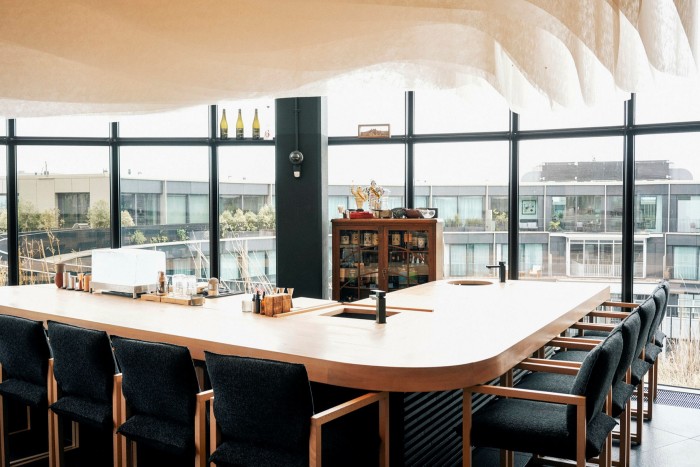
“Please relax — this is not Mayfair,” Endo Kazutoshi, a third-generation sushi master born in Yokohama, announced with a cheeky smile. His restaurant, the one-Michelin-star Endo at the Rotunda, is decidedly not in W1, where you’d more typically find top-end Japanese cuisine (or dimly lit sushi joints for people who don’t eat). Endo wanted to set up somewhere different, opting for the top floor of a White City apartment building with glittering views across the Television Centre development. Designed by award-winning architect Kengo Kuma, the pared-back space is crowned with an ethereal light fixture to make it feel as though you’re dining in the clouds. Endo otherwise does not do modernity.
“Tradition is very important to me,” Endo said from behind the 200-year-old hinoki wood counter, as he handed me an oyster that had been cooked in soy sauce, the base of which goes back 70 years. It had been passed down from his master’s master, and its depth of flavour has been built over time. Even for a chef, Endo is scrupulous about ingredients. An udon dish called “Soup and Noodles” was three years in the making — the length of time it took him to negotiate an agreement with the particular noodle makers he wanted to source from near Okinawa, who work with only 10 chefs. Served with a light broth and steamed abalone, the thin noodles had a firm texture yet almost dissolved in my mouth. They were worth the wait.

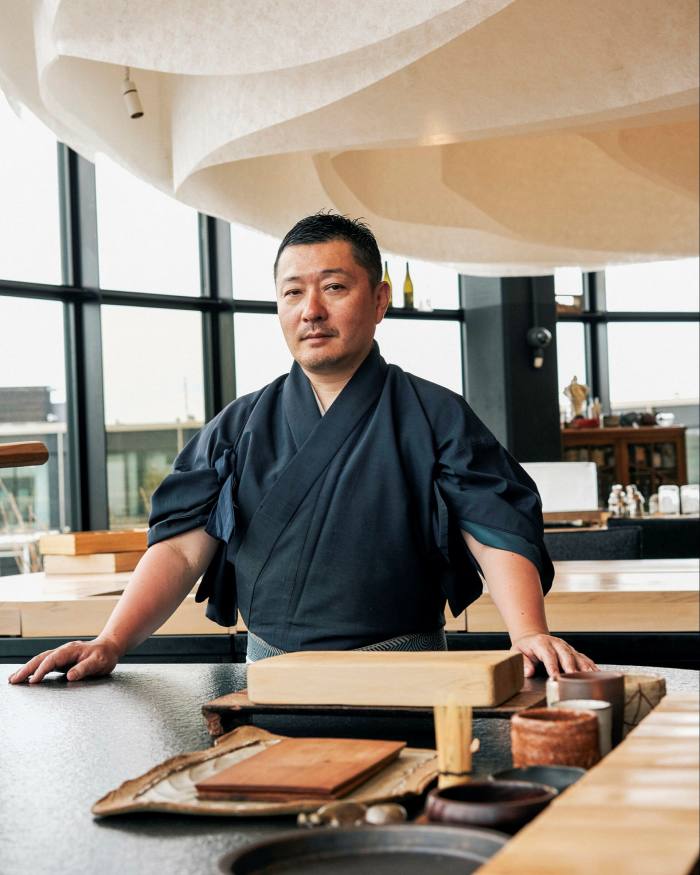
Another highlight was what Endo called his “business card”: tuna tamaki dramatically prepared for his 11-person audience with a maguro, a sword-like knife, and popped into folded seaweed like a taco filling. The seaweed was “the best of the best” — from the limited quantities of the first harvest of the year, available to very few chefs (but his family has known its suppliers since the dawn of time). Endo, by the way, makes sushi rice the way God surely intended: flavourful, falls apart just so, yet has an almost creamy texture.
Despite the seemingly endless courses, a meal here doesn’t feel greedy or weighty — and anyway, Endo, with his theatre performer’s energy, wouldn’t let lethargy take hold. “Ometanashi is the philosophy, I want to wake up the guests,” he said, citing the Japanese spirit of hospitality. “It’s about everyone being together, not just to eat. I want it to be memorable.”
Share your favourite chef’s tables in the comments
Follow FT Globetrotter on Instagram at @FTGlobetrotter
[ad_2]
Share this news on your Fb,Twitter and Whatsapp
NY Press News:Latest News Headlines
NY Press News||Health||New York||USA News||Technology||World News






